- A+
第3章 Flume进阶
3.1 Flume事务

3.2 Flume Agent内部原理
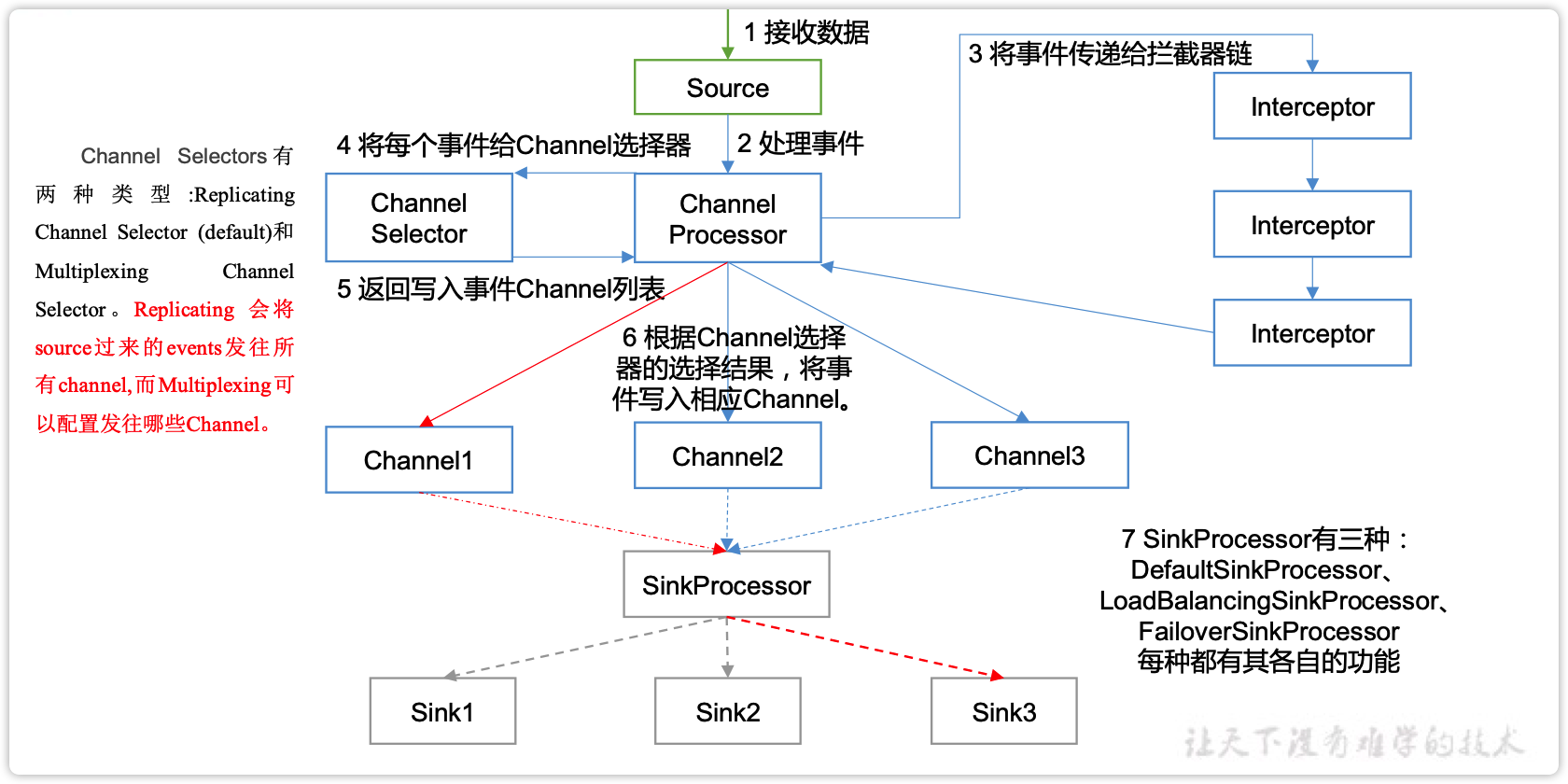
重要组件:
1)ChannelSelector
ChannelSelector的作用就是选出Event将要被发往哪个Channel。其共有两种类型,分别是Replicating(复制)和Multiplexing(多路复用)。
ReplicatingSelector会将同一个Event发往所有的Channel,Multiplexing会根据相应的原则,将不同的Event发往不同的Channel。
2)SinkProcessor
SinkProcessor共有三种类型,分别是DefaultSinkProcessor、LoadBalancingSinkProcessor和FailoverSinkProcessor
DefaultSinkProcessor对应的是单个的Sink,LoadBalancingSinkProcessor和FailoverSinkProcessor对应的是Sink Group,LoadBalancingSinkProcessor可以实现负载均衡的功能,FailoverSinkProcessor可以错误恢复的功能。
3.3 Flume拓扑结构
3.3.1 简单串联

这种模式是将多个flume顺序连接起来了,从最初的source开始到最终sink传送的目的存储系统。此模式不建议桥接过多的flume数量, flume数量过多不仅会影响传输速率,而且一旦传输过程中某个节点flume宕机,会影响整个传输系统。
3.3.2 复制和多路复用
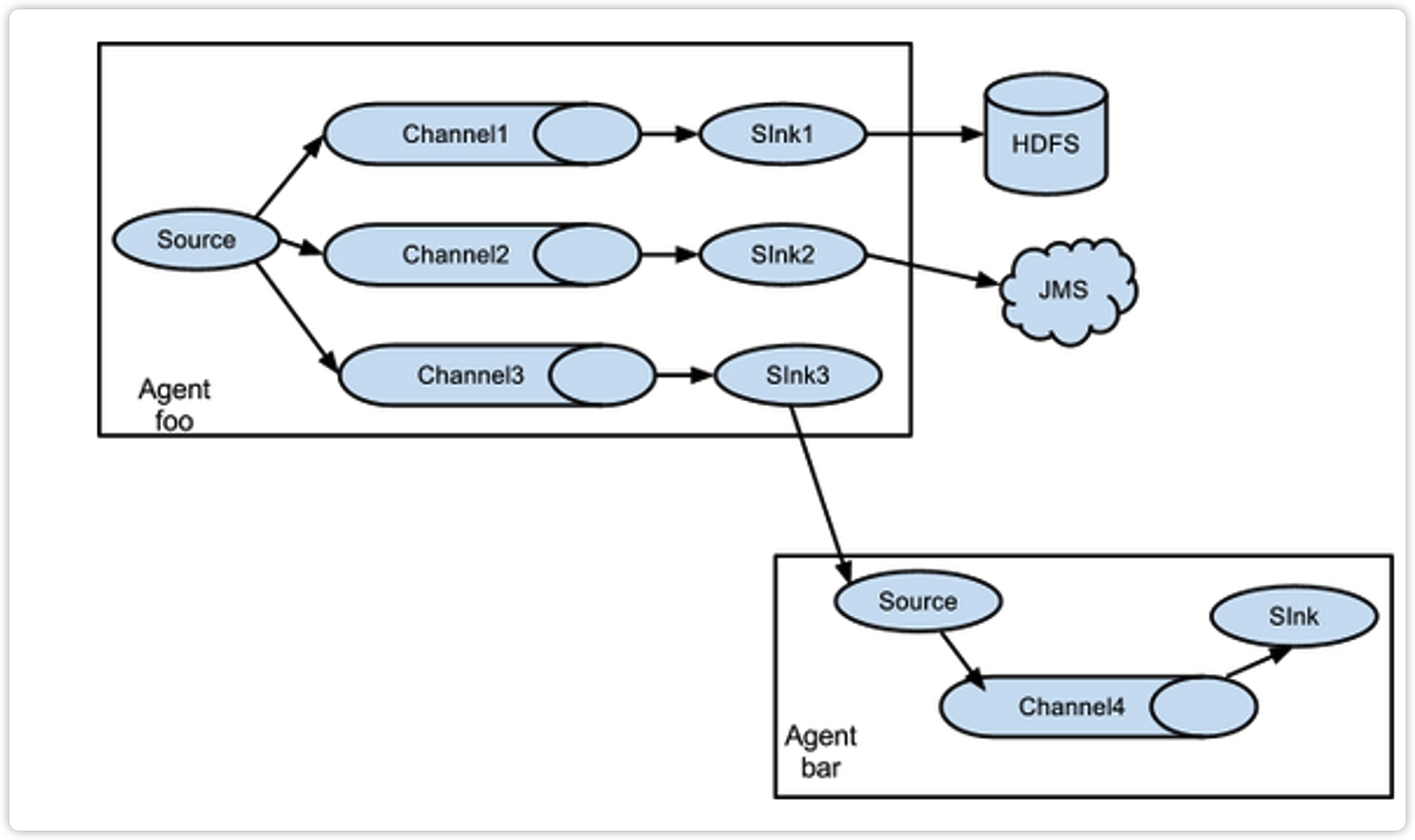
Flume支持将事件流向一个或者多个目的地。这种模式可以将相同数据复制到多个channel中,或者将不同数据分发到不同的channel中,sink可以选择传送到不同的目的地。
3.3.3 负载均衡和故障转移
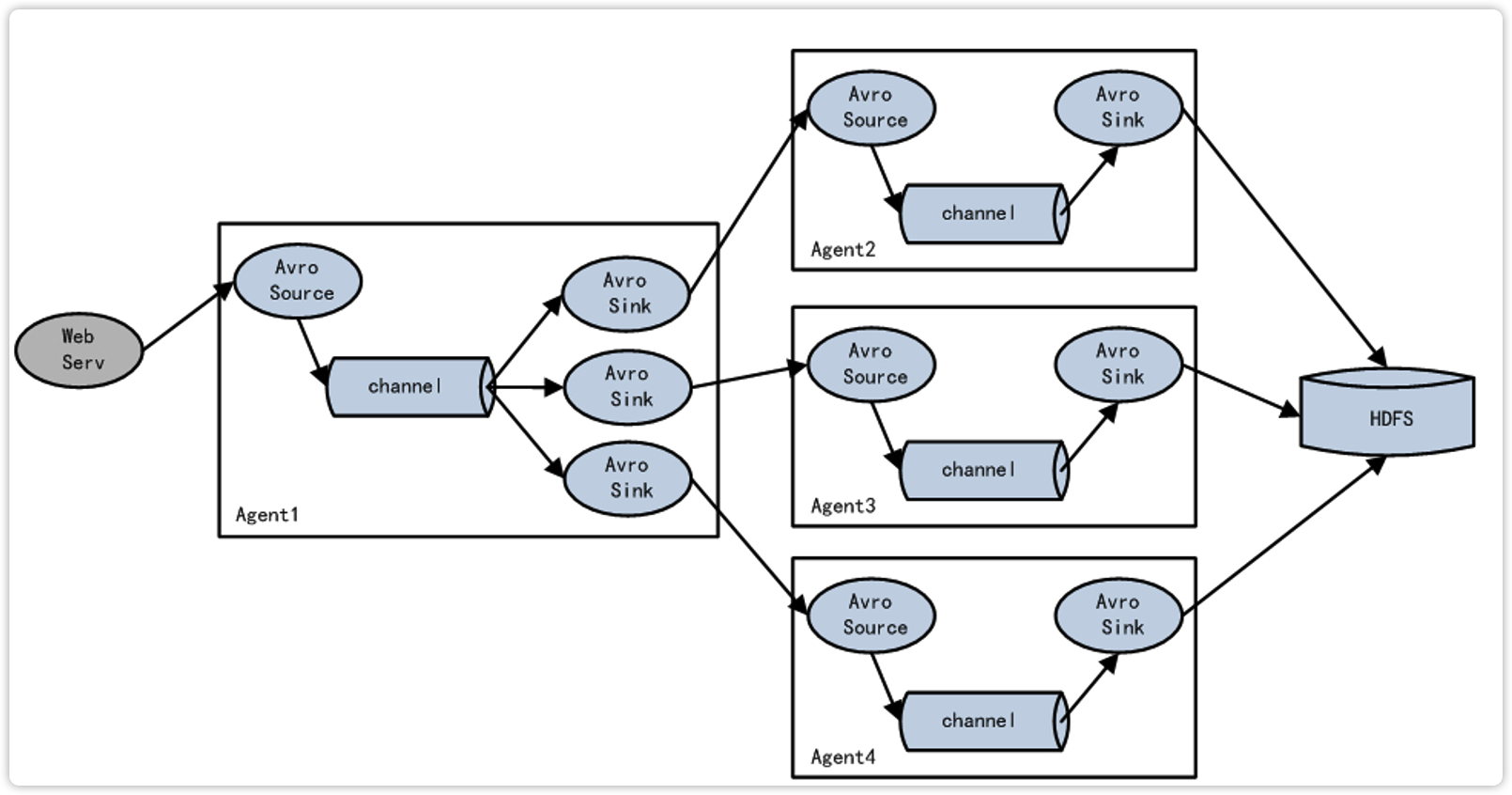
Flume支持使用将多个sink逻辑上分到一个sink组,sink组配合不同的SinkProcessor可以实现负载均衡和错误恢复的功能。
3.3.4 聚合
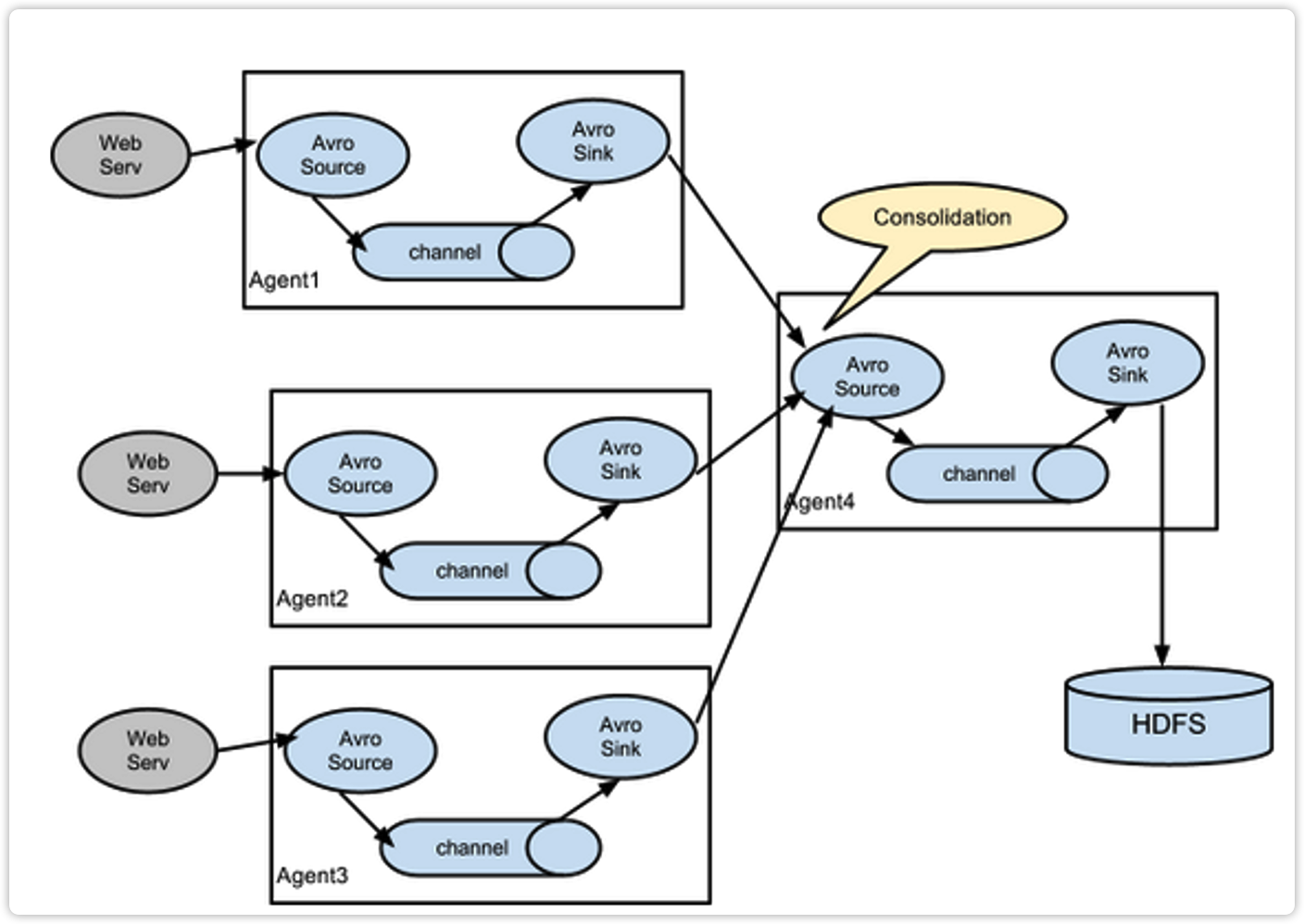
这种模式是我们最常见的,也非常实用,日常web应用通常分布在上百个服务器,大者甚至上千个、上万个服务器。产生的日志,处理起来也非常麻烦。用flume的这种组合方式能很好的解决这一问题,每台服务器部署一个flume采集日志,传送到一个集中收集日志的flume,再由此flume上传到hdfs、hive、hbase等,进行日志分析。
3.4 Flume企业开发案例
3.4.1 复制和多路复用
1)案例需求
使用Flume-1监控文件变动,Flume-1将变动内容传递给Flume-2,Flume-2负责存储到HDFS。同时Flume-1将变动内容传递给Flume-3,Flume-3负责输出到Local FileSystem。
2)需求分析:

3)实现步骤:
(1)准备工作
在/opt/module/flume-1.9.0/job/目录下创建replicating文件夹
[wolffy@hadoop102 job]$ mkdir replicating 在/opt/module/flume-1.9.0/job/目录下创建file_roll文件夹
[wolffy@hadoop102 job]$ mkdir file_roll (2)创建a1.conf
配置1个接收日志文件的source和两个channel、两个sink,分别输送给a2和a3。
编辑配置文件
[wolffy@hadoop102 group1]$ vim a1.conf 添加如下内容
# Name a1.sources = r1 a1.sinks = k1 k2 a1.channels = c1 c2 # source a1.sources.r1.type = exec a1.sources.r1.command = tail -F /opt/module/hive-3.1.2/logs/hive.log # sink1 a1.sinks.k1.type = avro a1.sinks.k1.hostname = hadoop102 a1.sinks.k1.port = 5555 # sink2 a1.sinks.k2.type = avro a1.sinks.k2.hostname = hadoop102 a1.sinks.k2.port = 6666 # Channel a1.channels.c1.type = memory a1.channels.c1.capacity = 1000 a1.channels.c1.transactionCapacity = 100 # Channel a1.channels.c2.type = memory a1.channels.c2.capacity = 1000 a1.channels.c2.transactionCapacity = 100 # Channel Selector a1.sources.r1.selector.type = replicating # bind a1.sources.r1.channels = c1 c2 a1.sinks.k1.channel = c1 a1.sinks.k2.channel = c2 (3)创建a2.conf
配置上级Flume输出的Source,输出是到HDFS的Sink。
编辑配置文件
[wolffy@hadoop102 group1]$ vim a2.conf 添加如下内容
# Name a2.sources = r1 a2.sinks = k1 a2.channels = c1 # source a2.sources.r1.type = avro a2.sources.r1.bind = hadoop102 a2.sources.r1.port = 5555 # sink a2.sinks.k1.type = hdfs a2.sinks.k1.hdfs.path = hdfs://hadoop102:9820/flume/%Y%m%d/%H #上传文件的前缀 a2.sinks.k1.hdfs.filePrefix = logs- #是否按照时间滚动文件夹 a2.sinks.k1.hdfs.round = true #多少时间单位创建一个新的文件夹 a2.sinks.k1.hdfs.roundValue = 1 #重新定义时间单位 a2.sinks.k1.hdfs.roundUnit = hour #是否使用本地时间戳 a2.sinks.k1.hdfs.useLocalTimeStamp = true #积攒多少个Event才flush到HDFS一次 a2.sinks.k1.hdfs.batchSize = 100 #设置文件类型,可支持压缩 a2.sinks.k1.hdfs.fileType = DataStream #多久生成一个新的文件 a2.sinks.k1.hdfs.rollInterval = 30 #设置每个文件的滚动大小 a2.sinks.k1.hdfs.rollSize = 134217700 #文件的滚动与Event数量无关 a2.sinks.k1.hdfs.rollCount = 0 # Channel a2.channels.c1.type = memory a2.channels.c1.capacity = 1000 a2.channels.c1.transactionCapacity = 100 # bind a2.sources.r1.channels = c1 a2.sinks.k1.channel = c1 (4)创建a3.conf
配置上级Flume输出的Source,输出是到本地目录的Sink。
编辑配置文件
[wolffy@hadoop102 group1]$ vim flume-flume-dir.conf 添加如下内容
# Name a3.sources = r1 a3.sinks = k1 a3.channels = c1 # source a3.sources.r1.type = avro a3.sources.r1.bind = hadoop102 a3.sources.r1.port = 6666 # sink a3.sinks.k1.type = file_roll a3.sinks.k1.sink.directory = /opt/module/flume-1.9.0/job/file_roll # Channel a3.channels.c1.type = memory a3.channels.c1.capacity = 1000 a3.channels.c1.transactionCapacity = 100 # bind a3.sources.r1.channels = c1 a3.sinks.k1.channel = c1 提示:输出的本地目录必须是已经存在的目录,如果该目录不存在,并不会创建新的目录。
(5)执行配置文件
分别启动对应的flume进程:a3.conf,a2.conf,a1.conf。
[wolffy@hadoop102 flume-1.9.0]$ bin/flume-ng agent --conf conf/ --name a3 --conf-file job/replicating/a3.conf [wolffy@hadoop102 flume-1.9.0]$ bin/flume-ng agent --conf conf/ --name a2 --conf-file job/replicating/a2.conf [wolffy@hadoop102 flume-1.9.0]$ bin/flume-ng agent --conf conf/ --name a1 --conf-file job/replicating/a1.conf (6)启动Hadoop和Hive
[wolffy@hadoop102 hadoop-2.7.2]$ sbin/start-dfs.sh [wolffy@hadoop103 hadoop-2.7.2]$ sbin/start-yarn.sh [wolffy@hadoop102 hive]$ bin/hive hive (default)> (7)检查HDFS上数据
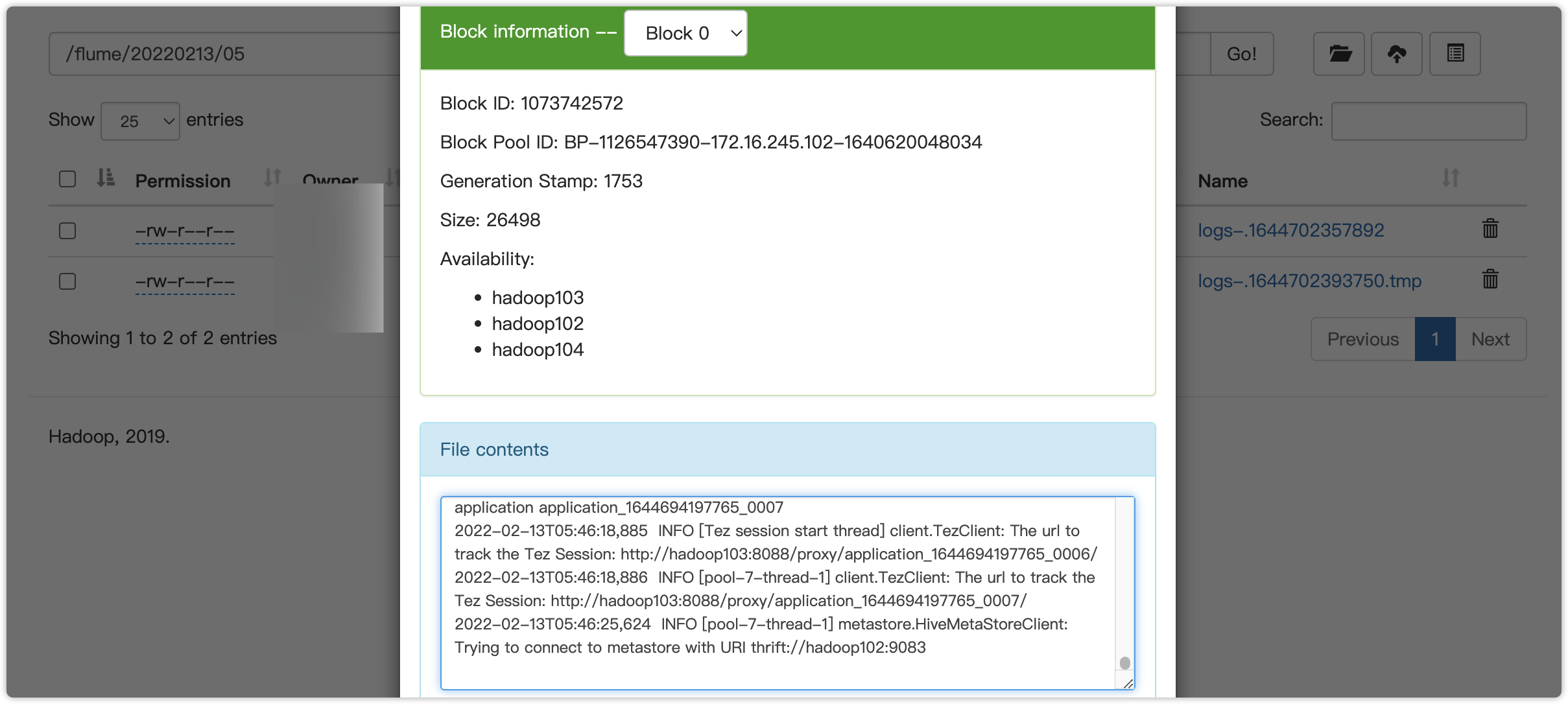
(8)检查/opt/module/datas/flume3目录中数据
[wolffy@hadoop102 flume3]$ ll 总用量 8 -rw-rw-r--. 1 wolffy wolffy 5942 5月 22 00:09 1526918887550-3 3.4.2 负载均衡和故障转移
1)案例需求
使用Flume1监控一个端口,其sink组中的sink分别对接Flume2和Flume3,采用FailoverSinkProcessor,实现故障转移的功能。
2)需求分析

3)实现步骤
(1)准备工作
在/opt/module/flume-1.9.0/job/目录下创建failover文件夹
[wolffy@hadoop102 job]$ mkdir failover/ [wolffy@hadoop102 job]$ cd failover/ (2)创建a1.conf
配置1个netcat source和1个channel、1个sink group(2个sink),分别输送给a2.conf和a3.conf。
编辑配置文件
[wolffy@hadoop102 group2]$ vim a1.conf 添加如下内容
# Name a1.sources = r1 a1.sinks = k1 k2 a1.channels = c1 # source a1.sources.r1.type = netcat a1.sources.r1.bind = hadoop102 a1.sources.r1.port = 4444 # sink1 a1.sinks.k1.type = avro a1.sinks.k1.hostname = hadoop102 a1.sinks.k1.port = 5555 # sink2 a1.sinks.k2.type = avro a1.sinks.k2.hostname = hadoop102 a1.sinks.k2.port = 6666 # sink processor a1.sinkgroups = g1 a1.sinkgroups.g1.sinks = k1 k2 a1.sinkgroups.g1.processor.type = failover a1.sinkgroups.g1.processor.priority.k1 = 5 a1.sinkgroups.g1.processor.priority.k2 = 10 a1.sinkgroups.g1.processor.maxpenalty = 10000 # Channel a1.channels.c1.type = memory a1.channels.c1.capacity = 1000 a1.channels.c1.transactionCapacity = 100 # bind a1.sources.r1.channels = c1 a1.sinks.k1.channel = c1 a1.sinks.k2.channel = c1 (3)创建a2.conf
配置上级Flume输出的Source,输出是到本地控制台。
编辑配置文件
[wolffy@hadoop102 group2]$ vim a2.conf 添加如下内容
# Name a2.sources = r1 a2.sinks = k1 a2.channels = c1 # source a2.sources.r1.type = avro a2.sources.r1.bind = hadoop102 a2.sources.r1.port = 5555 # sink a2.sinks.k1.type = logger # Channel a2.channels.c1.type = memory a2.channels.c1.capacity = 1000 a2.channels.c1.transactionCapacity = 100 # bind a2.sources.r1.channels = c1 a2.sinks.k1.channel = c1 (4)创建a3.conf
配置上级Flume输出的Source,输出是到本地控制台。
编辑配置文件
[wolffy@hadoop102 group2]$ vim a3.conf 添加如下内容
# Name a3.sources = r1 a3.sinks = k1 a3.channels = c1 # source a3.sources.r1.type = avro a3.sources.r1.bind = hadoop102 a3.sources.r1.port = 6666 # sink a3.sinks.k1.type = logger # Channel a3.channels.c1.type = memory a3.channels.c1.capacity = 1000 a3.channels.c1.transactionCapacity = 100 # bind a3.sources.r1.channels = c1 a3.sinks.k1.channel = c1 (5)执行配置文件
分别开启对应配置文件:a3.conf,a2.conf,a1.conf。
[wolffy@hadoop102 lume-1.9.0]$ bin/flume-ng agent --conf conf/ --name a3 --conf-file job/failover/a3.conf -Dflume.wolffy.logger=INFO,console [wolffy@hadoop102 flulume-1.9.0me]$ bin/flume-ng agent --conf conf/ --name a2 --conf-file job/failover/a3.conf -Dflume.root.logger=INFO,console [wolffy@hadoop102 lume-1.9.0]$ bin/flume-ng agent --conf conf/ --name a1 --conf-file job/failover/a1.conf (6)使用netcat工具向本机的44444端口发送内容
[wolffy@hadoop102 failover]$ nc hadoop102 4444 (7)查看Flume2及Flume3的控制台打印日志
(8)将Flume2 kill,观察Flume3的控制台打印情况。
2022-02-13 06:40:14,235 (SinkRunner-PollingRunner-DefaultSinkProcessor) [INFO - org.apache.flume.sink.LoggerSink.process(LoggerSink.java:95)] Event: { headers:{} body: 68 65 6C 6C 6F hello } 注:使用jps -ml查看Flume进程。
3.4.3 负载均衡
a1.conf
# Name a1.sources = r1 a1.sinks = k1 k2 a1.channels = c1 # source a1.sources.r1.type = netcat a1.sources.r1.bind = hadoop102 a1.sources.r1.port = 4444 # sink1 a1.sinks.k1.type = avro a1.sinks.k1.hostname = hadoop102 a1.sinks.k1.port = 5555 # sink2 a1.sinks.k2.type = avro a1.sinks.k2.hostname = hadoop102 a1.sinks.k2.port = 6666 # sink processor a1.sinkgroups = g1 a1.sinkgroups.g1.sinks = k1 k2 a1.sinkgroups.g1.processor.type = load_balance a1.sinkgroups.g1.processor.selector = round_robin # 退避 a1.sinkgroups.g1.processor.backoff = true # Channel a1.channels.c1.type = memory a1.channels.c1.capacity = 1000 a1.channels.c1.transactionCapacity = 100 # bind a1.sources.r1.channels = c1 a1.sinks.k1.channel = c1 a1.sinks.k2.channel = c1 a2.conf
# Name a2.sources = r1 a2.sinks = k1 a2.channels = c1 # source a2.sources.r1.type = avro a2.sources.r1.bind = hadoop102 a2.sources.r1.port = 5555 # sink a2.sinks.k1.type = logger # Channel a2.channels.c1.type = memory a2.channels.c1.capacity = 1000 a2.channels.c1.transactionCapacity = 100 # bind a2.sources.r1.channels = c1 a2.sinks.k1.channel = c1 a3.conf
# Name a3.sources = r1 a3.sinks = k1 a3.channels = c1 # source a3.sources.r1.type = avro a3.sources.r1.bind = hadoop102 a3.sources.r1.port = 6666 # sink a3.sinks.k1.type = logger # Channel a3.channels.c1.type = memory a3.channels.c1.capacity = 1000 a3.channels.c1.transactionCapacity = 100 # bind a3.sources.r1.channels = c1 a3.sinks.k1.channel = c1 3.4.4 聚合
1)案例需求:
hadoop102上的Flume-1监控文件/opt/module/group.log,
hadoop103上的Flume-2监控某一个端口的数据流,
Flume-1与Flume-2将数据发送给hadoop104上的Flume-3,Flume-3将最终数据打印到控制台。
2)需求分析

3)实现步骤:
(1)准备工作
分发Flume
[wolffy@hadoop102 module]$ xsync flume-1.9.0 在hadoop102、hadoop103以及hadoop104的/opt/module/flume1.9.0/job目录下创建一个aggre文件夹。
[wolffy@hadoop102 job]$ mkdir aggre [wolffy@hadoop103 job]$ mkdir aggre [wolffy@hadoop104 job]$ mkdir aggre (2)创建flume1-logger-flume.conf
配置Source用于监控hive.log文件,配置Sink输出数据到下一级Flume。
在hadoop102上编辑配置文件
[wolffy@hadoop102 group3]$ vim a1.conf 添加如下内容
[wolffy@hadoop102 aggre]$ cat a1.txt # Name a1.sources = r1 a1.sinks = k1 a1.channels = c1 # source a1.sources.r1.type = exec a1.sources.r1.command = tail -F /opt/module/hive-3.1.2/logs/hive.log # sink1 a1.sinks.k1.type = avro a1.sinks.k1.hostname = hadoop104 a1.sinks.k1.port = 8888 # Channel a1.channels.c1.type = memory a1.channels.c1.capacity = 1000 a1.channels.c1.transactionCapacity = 100 # bind a1.sources.r1.channels = c1 a1.sinks.k1.channel = c1 (3)创建a2conf
配置Source监控端口44444数据流,配置Sink数据到下一级Flume:
在hadoop103上编辑配置文件
[wolffy@hadoop102 group3]$ vim a2.conf 添加如下内容
# Name a2.sources = r1 a2.sinks = k1 a2.channels = c1 # source a2.sources.r1.type = netcat a2.sources.r1.bind = hadoop103 a2.sources.r1.port = 4444 # sink a2.sinks.k1.type = avro a2.sinks.k1.hostname = hadoop104 a2.sinks.k1.port = 8888 # Channel a2.channels.c1.type = memory a2.channels.c1.capacity = 1000 a2.channels.c1.transactionCapacity = 100 # bind a2.sources.r1.channels = c1 a2.sinks.k1.channel = c1 (4)创建flume3-flume-logger.conf
配置source用于接收flume1与flume2发送过来的数据流,最终合并后sink到控制台。
在hadoop104上编辑配置文件
[wolffy@hadoop104 group3]$ touch a3.conf [wolffy@hadoop104 group3]$ vim a3.conf 添加如下内容
# Name a3.sources = r1 a3.sinks = k1 a3.channels = c1 # source a3.sources.r1.type = avro a3.sources.r1.bind = hadoop104 a3.sources.r1.port = 8888 # sink a3.sinks.k1.type = logger # Channel a3.channels.c1.type = memory a3.channels.c1.capacity = 1000 a3.channels.c1.transactionCapacity = 100 # bind a3.sources.r1.channels = c1 a3.sinks.k1.channel = c1 (5)执行配置文件
分别开启对应配置文件:a3.conf,a2.conf,a1.conf。
[root@hadoop104 flume]$ bin/flume-ng agent --conf conf/ --name a3 --conf-file job/aggre/a3.conf -Dflume.root.logger=INFO,console [root@hadoop102 flume]$ bin/flume-ng agent --conf conf/ --name a1 --conf-file job/aggre/a1.conf [root@hadoop103 flume]$ bin/flume-ng agent --conf conf/ --name a2 --conf-file job/aggre/a2.conf (6)在hadoop102上向启动bin/hive
[root@hadoop102 hive-3.1.2]$ bin/hive Hive Session ID = 1a14279f-53b3-47e9-9504-534fb461235f Logging initialized using configuration in file:/opt/module/hive-3.1.2/conf/hive-log4j2.properties Async: true Hive Session ID = a54853cc-e857-43ee-b305-dc644db44b84 hive (default)> (7)在hadoop103上向4444端口发送数据
[root@hadoop103 flume]$ nc hadoop103 4444 (8)检查hadoop104上数据
2022-02-13 07:31:44,850 (SinkRunner-PollingRunner-DefaultSinkProcessor) [INFO - org.apache.flume.sink.LoggerSink.process(LoggerSink.java:95)] Event: { headers:{} body: 32 30 32 32 2D 30 32 2D 31 33 54 30 37 3A 33 31 2022-02-13T07:31 } 2022-02-13 07:31:44,850 (SinkRunner-PollingRunner-DefaultSinkProcessor) [INFO - org.apache.flume.sink.LoggerSink.process(LoggerSink.java:95)] Event: { headers:{} body: 32 30 32 32 2D 30 32 2D 31 33 54 30 37 3A 33 31 2022-02-13T07:31 } 2022-02-13 07:31:45,854 (SinkRunner-PollingRunner-DefaultSinkProcessor) [INFO - org.apache.flume.sink.LoggerSink.process(LoggerSink.java:95)] Event: { headers:{} body: 32 30 32 32 2D 30 32 2D 31 33 54 30 37 3A 33 31 2022-02-13T07:31 } hello } 3.5 自定义Interceptor
1)案例需求
使用Flume采集服务器本地日志,需要按照日志类型的不同,将不同种类的日志发往不同的分析系统。
2)需求分析
在实际的开发中,一台服务器产生的日志类型可能有很多种,不同类型的日志可能需要发送到不同的分析系统。此时会用到Flume拓扑结构中的Multiplexing结构,Multiplexing的原理是,根据event中Header的某个key的值,将不同的event发送到不同的Channel中,所以我们需要自定义一个Interceptor,为不同类型的event的Header中的key赋予不同的值。
在该案例中,我们以端口数据模拟日志,以数字(单个)和字母(单个)模拟不同类型的日志,我们需要自定义interceptor区分数字和字母,将其分别发往不同的分析系统(Channel)。

3)实现步骤
(1)创建一个maven项目,并引入以下依赖。
<dependency> <groupId>org.apache.flume</groupId> <artifactId>flume-ng-core</artifactId> <version>1.9.0</version> </dependency> (2)定义CustomInterceptor类并实现Interceptor接口。
package com.bdreasercher.bigdata; import org.apache.flume.Context; import org.apache.flume.Event; import org.apache.flume.interceptor.Interceptor; import java.util.List; public class CustomInterceptor implements Interceptor { @Override public void initialize() { } @Override public Event intercept(Event event) { byte[] body = event.getBody(); if (body[0] < 'z' && body[0] > 'a') { event.getHeaders().put("type", "letter"); } else if (body[0] > '0' && body[0] < '9') { event.getHeaders().put("type", "number"); } return event; } @Override public List<Event> intercept(List<Event> events) { for (Event event : events) { intercept(event); } return events; } @Override public void close() { } public static class Builder implements Interceptor.Builder { @Override public Interceptor build() { return new CustomInterceptor(); } @Override public void configure(Context context) { } } } 打包,把编译好的Jar包房到lib文件夹下。
(3)编辑flume配置文件
为hadoop102上的Flume1配置1个netcat source,1个sink group(2个avro sink),并配置相应的ChannelSelector和interceptor。
# Name the components on this agent a1.sources = r1 a1.sinks = k1 k2 a1.channels = c1 c2 # Describe/configure the source a1.sources.r1.type = netcat a1.sources.r1.bind = 0.0.0.0 a1.sources.r1.port = 44444 a1.sources.r1.interceptors = i1 a1.sources.r1.interceptors.i1.type = com.bdreasercher.bigdata.CustomInterceptor$Builder a1.sources.r1.selector.type = multiplexing a1.sources.r1.selector.header = type a1.sources.r1.selector.mapping.letter = c1 a1.sources.r1.selector.mapping.number = c2 # Describe the sink a1.sinks.k1.type = avro a1.sinks.k1.hostname = hadoop103 a1.sinks.k1.port = 4141 a1.sinks.k2.type=avro a1.sinks.k2.hostname = hadoop104 a1.sinks.k2.port = 4242 # Use a channel which buffers events in memory a1.channels.c1.type = memory a1.channels.c1.capacity = 1000 a1.channels.c1.transactionCapacity = 100 # Use a channel which buffers events in memory a1.channels.c2.type = memory a1.channels.c2.capacity = 1000 a1.channels.c2.transactionCapacity = 100 # Bind the source and sink to the channel a1.sources.r1.channels = c1 c2 a1.sinks.k1.channel = c1 a1.sinks.k2.channel = c2 为hadoop103上的Flume4配置一个avro source和一个logger sink。
a1.sources = r1 a1.sinks = k1 a1.channels = c1 a1.sources.r1.type = avro a1.sources.r1.bind = hadoop103 a1.sources.r1.port = 4141 a1.sinks.k1.type = logger a1.channels.c1.type = memory a1.channels.c1.capacity = 1000 a1.channels.c1.transactionCapacity = 100 a1.sinks.k1.channel = c1 a1.sources.r1.channels = c1 为hadoop104上的Flume3配置一个avro source和一个logger sink。
a1.sources = r1 a1.sinks = k1 a1.channels = c1 a1.sources.r1.type = avro a1.sources.r1.bind = hadoop104 a1.sources.r1.port = 4242 a1.sinks.k1.type = logger a1.channels.c1.type = memory a1.channels.c1.capacity = 1000 a1.channels.c1.transactionCapacity = 100 a1.sinks.k1.channel = c1 a1.sources.r1.channels = c1 (4)分别在hadoop102,hadoop103,hadoop104上启动flume进程,注意先后顺序。
(5)在hadoop102使用netcat向localhost:44444发送字母和数字。
(6)观察hadoop103和hadoop104打印的日志。
3.6 自定义Source
1)介绍
Source是负责接收数据到Flume Agent的组件。Source组件可以处理各种类型、各种格式的日志数据,包括avro、thrift、exec、jms、spooling directory、netcat、sequence generator、syslog、http、legacy。官方提供的source类型已经很多,但是有时候并不能满足实际开发当中的需求,此时我们就需要根据实际需求自定义某些source。
官方也提供了自定义source的接口:https://flume.apache.org/FlumeDeveloperGuide.html#source根据官方说明自定义MySource需要继承AbstractSource类并实现Configurable和PollableSource接口。
实现相应方法:
getBackOffSleepIncrement() //backoff 步长
getMaxBackOffSleepInterval()//backoff 最长时间
configure(Context context)//初始化context(读取配置文件内容)
process()//获取数据封装成event并写入channel,这个方法将被循环调用。
使用场景:读取MySQL数据或者其他文件系统。
2)需求
使用flume接收数据,并给每条数据添加前缀,输出到控制台。前缀可从flume配置文件中配置。
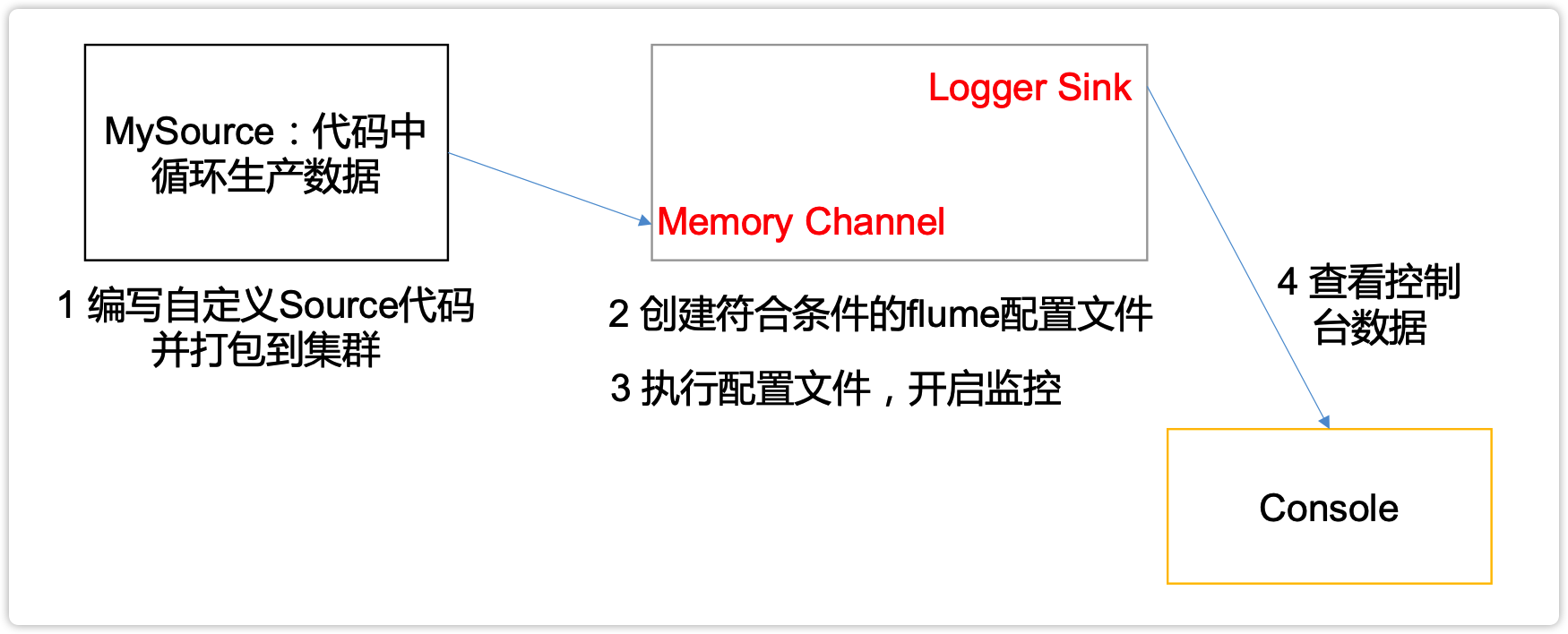

4)编码
(1)导入pom依赖
<dependencies> <dependency> <groupId>org.apache.flume</groupId> <artifactId>flume-ng-core</artifactId> <version>1.9.0</version> </dependency> (2)编写代码
package com.bdreasercher.bigdata; import org.apache.flume.Context; import org.apache.flume.EventDeliveryException; import org.apache.flume.PollableSource; import org.apache.flume.conf.Configurable; import org.apache.flume.event.SimpleEvent; import org.apache.flume.source.AbstractSource; import java.util.HashMap; public class MySource extends AbstractSource implements Configurable, PollableSource { //定义配置文件将来要读取的字段 private Long delay; private String field; //初始化配置信息 @Override public void configure(Context context) { delay = context.getLong("delay"); field = context.getString("field", "Hello!"); } @Override public Status process() throws EventDeliveryException { try { //创建事件头信息 HashMap<String, String> hearderMap = new HashMap<>(); //创建事件 SimpleEvent event = new SimpleEvent(); //循环封装事件 for (int i = 0; i < 5; i++) { //给事件设置头信息 event.setHeaders(hearderMap); //给事件设置内容 event.setBody((field + i).getBytes()); //将事件写入channel getChannelProcessor().processEvent(event); Thread.sleep(delay); } } catch (Exception e) { e.printStackTrace(); return Status.BACKOFF; } return Status.READY; } @Override public long getBackOffSleepIncrement() { return 0; } @Override public long getMaxBackOffSleepInterval() { return 0; } } 5)测试
(1)打包
将写好的代码打包,并放到flume的lib目录(/opt/module/flume-1.9.0/lib)下。
(2)配置文件
# Name the components on this agent a1.sources = r1 a1.sinks = k1 a1.channels = c1 # Describe/configure the source a1.sources.r1.type = com.bdreasercher.bigdata.MySource a1.sources.r1.delay = 1000 #a1.sources.r1.field = root # Describe the sink a1.sinks.k1.type = logger # Use a channel which buffers events in memory a1.channels.c1.type = memory a1.channels.c1.capacity = 1000 a1.channels.c1.transactionCapacity = 100 # Bind the source and sink to the channel a1.sources.r1.channels = c1 a1.sinks.k1.channel = c1 (3)开启任务
[root@hadoop102 flume-1.9.0]$ bin/flume-ng agent -c conf/ -f job/mysource.conf -n a1 -Dflume.root.logger=INFO,console (4)结果展示

3.7 自定义Sink
1)介绍
Sink不断地轮询Channel中的事件且批量地移除它们,并将这些事件批量写入到存储或索引系统、或者被发送到另一个Flume Agent。
Sink是完全事务性的。在从Channel批量删除数据之前,每个Sink用Channel启动一个事务。批量事件一旦成功写出到存储系统或下一个Flume Agent,Sink就利用Channel提交事务。事务一旦被提交,该Channel从自己的内部缓冲区删除事件。
Sink组件目的地包括hdfs、logger、avro、thrift、ipc、file、null、HBase、solr、自定义。官方提供的Sink类型已经很多,但是有时候并不能满足实际开发当中的需求,此时我们就需要根据实际需求自定义某些Sink。
官方也提供了自定义sink的接口:https://flume.apache.org/FlumeDeveloperGuide.html#sink根据官方说明自定义MySink需要继承AbstractSink类并实现Configurable接口。
实现相应方法:
configure(Context context)//初始化context(读取配置文件内容)
process()//从Channel读取获取数据(event),这个方法将被循环调用。
使用场景:读取Channel数据写入MySQL或者其他文件系统。
2)需求
使用flume接收数据,并在Sink端给每条数据添加前缀和后缀,输出到控制台。前后缀可在flume任务配置文件中配置。
流程分析:
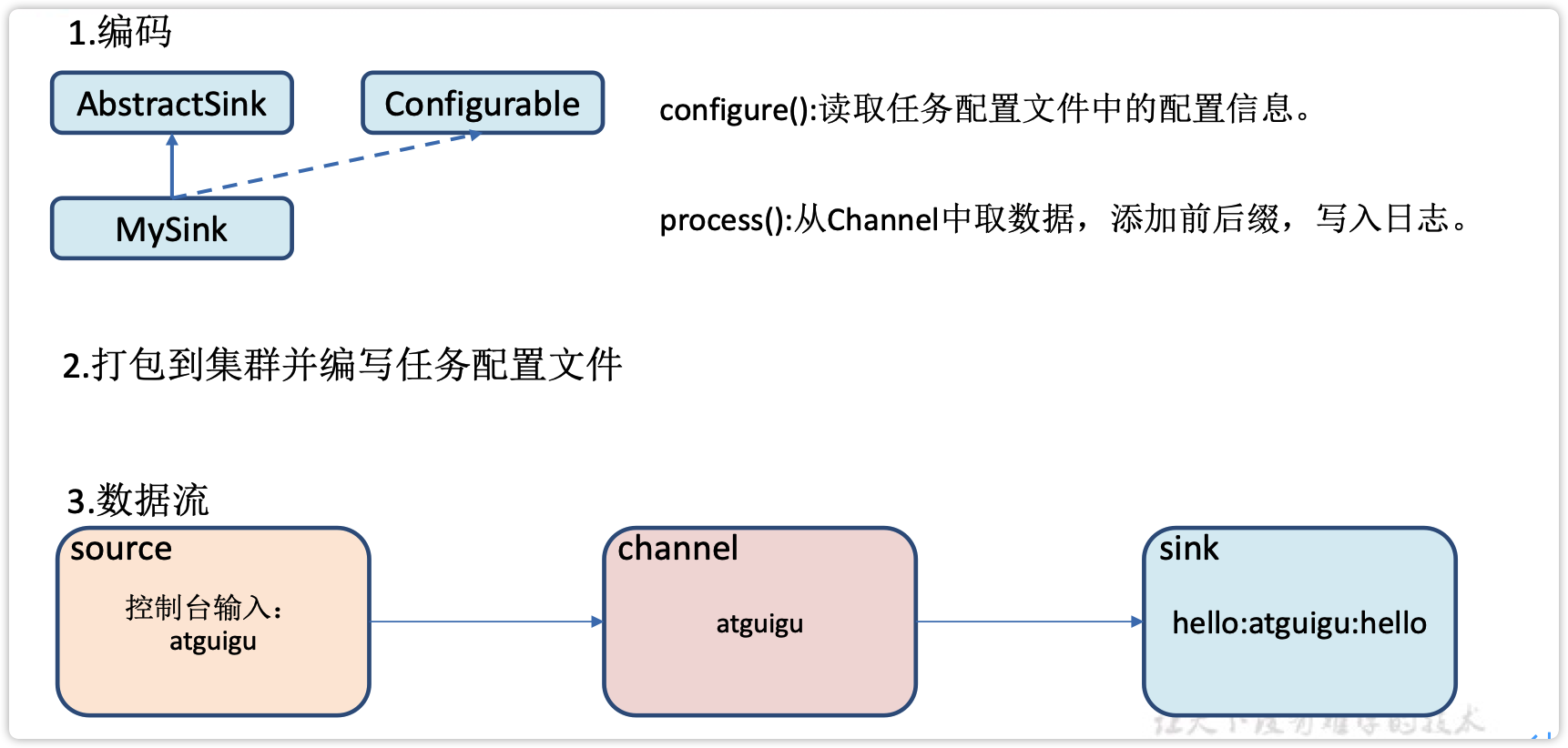
3)编码
package com.bdreasercher.bigdata; import org.apache.flume.*; import org.apache.flume.conf.Configurable; import org.apache.flume.sink.AbstractSink; import org.slf4j.Logger; import org.slf4j.LoggerFactory; public class MySink extends AbstractSink implements Configurable { //创建Logger对象 private static final Logger LOG = LoggerFactory.getLogger(AbstractSink.class); private String prefix; private String suffix; @Override public Status process() throws EventDeliveryException { //声明返回值状态信息 Status status; //获取当前Sink绑定的Channel Channel ch = getChannel(); //获取事务 Transaction txn = ch.getTransaction(); //声明事件 Event event; //开启事务 txn.begin(); //读取Channel中的事件,直到读取到事件结束循环 while (true) { event = ch.take(); if (event != null) { break; } } try { //处理事件(打印) LOG.info(prefix + new String(event.getBody()) + suffix); //事务提交 txn.commit(); status = Status.READY; } catch (Exception e) { //遇到异常,事务回滚 txn.rollback(); status = Status.BACKOFF; } finally { //关闭事务 txn.close(); } return status; } @Override public void configure(Context context) { //读取配置文件内容,有默认值 prefix = context.getString("prefix", "hello:"); //读取配置文件内容,无默认值 suffix = context.getString("suffix"); } } 4)测试
(1)打包
将写好的代码打包,并放到flume的lib目录(/opt/module/flume-1.9.0/lib)下。
(2)配置文件
# Name the components on this agent a1.sources = r1 a1.sinks = k1 a1.channels = c1 # Describe/configure the source a1.sources.r1.type = netcat a1.sources.r1.bind = localhost a1.sources.r1.port = 44444 # Describe the sink a1.sinks.k1.type = com.bdreasercher.bigdata.MySink #a1.sinks.k1.prefix = root: a1.sinks.k1.suffix = :root # Use a channel which buffers events in memory a1.channels.c1.type = memory a1.channels.c1.capacity = 1000 a1.channels.c1.transactionCapacity = 100 # Bind the source and sink to the channel a1.sources.r1.channels = c1 a1.sinks.k1.channel = c1 (3)开启任务
[root@hadoop102 flume-1.9.0]$ bin/flume-ng agent -c conf/ -f job/mysink.conf -n a1 -Dflume.root.logger=INFO,console [root@hadoop102 ~]$ nc localhost 44444 hello OK root OK (4)结果展示
3.8 Flume数据流监控
3.8.1 Ganglia的安装与部署
Ganglia由gmond、gmetad、gweb三部分组成。
-
gmond(Ganglia Monitoring Daemon)是一种轻量级服务,安装在每台需要收集指标数据的节点主机上。使用gmond,你可以很容易收集很多系统指标数据,如CPU、内存、磁盘、网络和活跃进程的数据等。
-
gmetad(Ganglia Meta Daemon)整合所有信息,并将其以RRD格式存储至磁盘的服务。
-
gweb(Ganglia Web)Ganglia可视化工具,gweb是一种利用浏览器显示gmetad所存储数据的PHP前端。在Web界面中以图表方式展现集群的运行状态下收集的多种不同指标数据。
1)安装ganglia
(1)规划
hadoop102: web gmetad gmod hadoop103: gmod hadoop104: gmod (2)在102 103 104分别安装epel-release
[root@hadoop102 flume-1.9.0]$ sudo yum -y install epel-release [root@hadoop103 flume-1.9.0]$ sudo yum -y install epel-release [root@hadoop104 flume-1.9.0]$ sudo yum -y install epel-release (3)在102 安装 web gmetad gmod
[root@hadoop102 flume-1.9.0]$ sudo yum -y install ganglia-gmetad [root@hadoop102 flume-1.9.0]$ sudo yum -y install ganglia-web [root@hadoop102 flume-1.9.0]$ sudo yum -y install ganglia-gmond (4)在103 和 104 安装 gmod
[root@hadoop103 flume-1.9.0]$ sudo yum -y install ganglia-gmond [root@hadoop104 flume-1.9.0]$ sudo yum -y install ganglia-gmond 2)在102修改配置文件 /etc/httpd/conf.d/ganglia.conf
[root@hadoop102 flume-1.9.0]$ sudo vim /etc/httpd/conf.d/ganglia.conf 修改为红颜色的配置:
# Ganglia monitoring system php web frontend Alias /ganglia /usr/share/ganglia <Location /ganglia> # Require ip 10.1.2.3 # Require host example.org Require all granted </Location> 5)在102修改配置文件/etc/ganglia/gmetad.conf
[root@hadoop102 flume-1.9.0]$ sudo vim /etc/ganglia/gmetad.conf 修改为:
data_source "my cluster" hadoop102 6)在102 103 104分别修改配置文件/etc/ganglia/gmond.conf
[root@hadoop102 flume-1.9.0]$ sudo vim /etc/ganglia/gmond.conf 修改为:
cluster { name = "my cluster" owner = "unspecified" latlong = "unspecified" url = "unspecified" } udp_send_channel { #bind_hostname = yes # Highly recommended, soon to be default. # This option tells gmond to use a source address # that resolves to the machine's hostname. Without # this, the metrics may appear to come from any # interface and the DNS names associated with # those IPs will be used to create the RRDs. # mcast_join = 239.2.11.71 # 数据发送给hadoop102 host = hadoop102 port = 8649 ttl = 1 } udp_recv_channel { # mcast_join = 239.2.11.71 port = 8649 # 接收来自任意连接的数据 bind = 0.0.0.0 retry_bind = true # Size of the UDP buffer. If you are handling lots of metrics you really # should bump it up to e.g. 10MB or even higher. # buffer = 10485760 } 7)在102修改配置文件 /etc/selinux/config
[root@hadoop102 flume-1.9.0]$ sudo vim /etc/selinux/config 修改为:
# This file controls the state of SELinux on the system. # SELINUX= can take one of these three values: # enforcing - SELinux security policy is enforced. # permissive - SELinux prints warnings instead of enforcing. # disabled - No SELinux policy is loaded. SELINUX=disabled # SELINUXTYPE= can take one of these two values: # targeted - Targeted processes are protected, # mls - Multi Level Security protection. SELINUXTYPE=targeted 尖叫提示:selinux本次生效关闭必须重启,如果此时不想重启,可以临时生效之:
[root@hadoop102 flume-1.9.0]$ sudo setenforce 0 8)启动ganglia
(1)在102 103 104 分别启动
[root@hadoop102 flume-1.9.0]$ sudo systemctl start gmond [root@hadoop104 flume-1.9.0]$ sudo systemctl status gmond ● gmond.service - Ganglia Monitoring Daemon Loaded: loaded (/usr/lib/systemd/system/gmond.service; disabled; vendor preset: disabled) Active: active (running) since 二 2022-01-25 20:32:00 CST; 2 weeks 4 days ago Process: 43115 ExecStart=/usr/sbin/gmond (code=exited, status=0/SUCCESS) Main PID: 43116 (gmond) CGroup: /system.slice/gmond.service └─43116 /usr/sbin/gmond 1月 25 20:32:00 hadoop104 systemd[1]: Starting Ganglia Monitoring Daemon... 1月 25 20:32:00 hadoop104 systemd[1]: Started Ganglia Monitoring Daemon. (2)在102 启动
[root@hadoop102 flume-1.9.0]$ sudo systemctl start httpd [root@hadoop102 flume-1.9.0]$ sudo systemctl status httpd ● httpd.service - The Apache HTTP Server Loaded: loaded (/usr/lib/systemd/system/httpd.service; disabled; vendor preset: disabled) Active: active (running) since 二 2022-01-25 20:41:19 CST; 2 weeks 4 days ago Docs: man:httpd(8) man:apachectl(8) Process: 86976 ExecStop=/bin/kill -WINCH ${MAINPID} (code=exited, status=0/SUCCESS) Process: 3268 ExecReload=/usr/sbin/httpd $OPTIONS -k graceful (code=exited, status=0/SUCCESS) Main PID: 86981 (httpd) Status: "Total requests: 0; Current requests/sec: 0; Current traffic: 0 B/sec" CGroup: /system.slice/httpd.service ├─ 3273 /usr/sbin/httpd -DFOREGROUND ├─ 3274 /usr/sbin/httpd -DFOREGROUND ├─ 3275 /usr/sbin/httpd -DFOREGROUND ├─ 3276 /usr/sbin/httpd -DFOREGROUND ├─ 3277 /usr/sbin/httpd -DFOREGROUND └─86981 /usr/sbin/httpd -DFOREGROUND [root@hadoop102 flume-1.9.0]$ sudo systemctl start gmetad [root@hadoop102 flume-1.9.0]$ sudo systemctl status gmetad ● gmetad.service - Ganglia Meta Daemon Loaded: loaded (/usr/lib/systemd/system/gmetad.service; disabled; vendor preset: disabled) Active: active (running) since 二 2022-01-25 20:32:17 CST; 2 weeks 4 days ago Main PID: 86918 (gmetad) CGroup: /system.slice/gmetad.service └─86918 /usr/sbin/gmetad -d 1 9)打开网页浏览ganglia页面

尖叫提示:如果完成以上操作依然出现权限不足错误,请修改/var/lib/ganglia目录的权限。
[root@hadoop102 flume-1.9.0]$ sudo chmod -R 777 /var/lib/ganglia 参考:https://www.cnblogs.com/cosmos-wong/p/11980500.html
3.8.2 操作Flume测试监控
1)启动Flume任务
[root@hadoop102 flume-1.9.0]$ bin/flume-ng agent -c conf/ -n a1 -f job/netcat-flume-logger.conf -Dflume.root.logger=INFO,console -Dflume.monitoring.type=ganglia -Dflume.monitoring.hosts=hadoop102:8649 2)发送数据观察ganglia监测图
[root@hadoop102 flume-1.9.0]$ nc localhost 6666 样式如图:
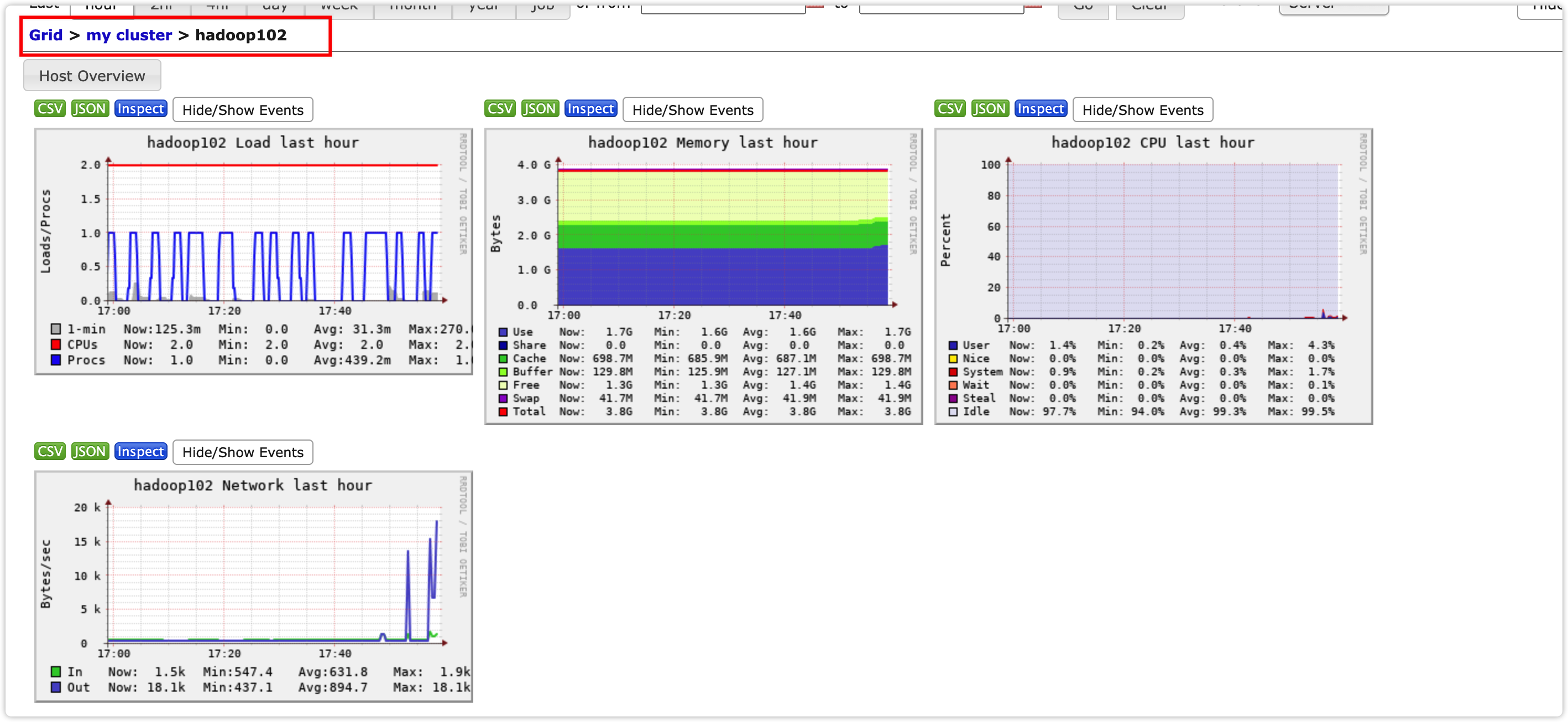
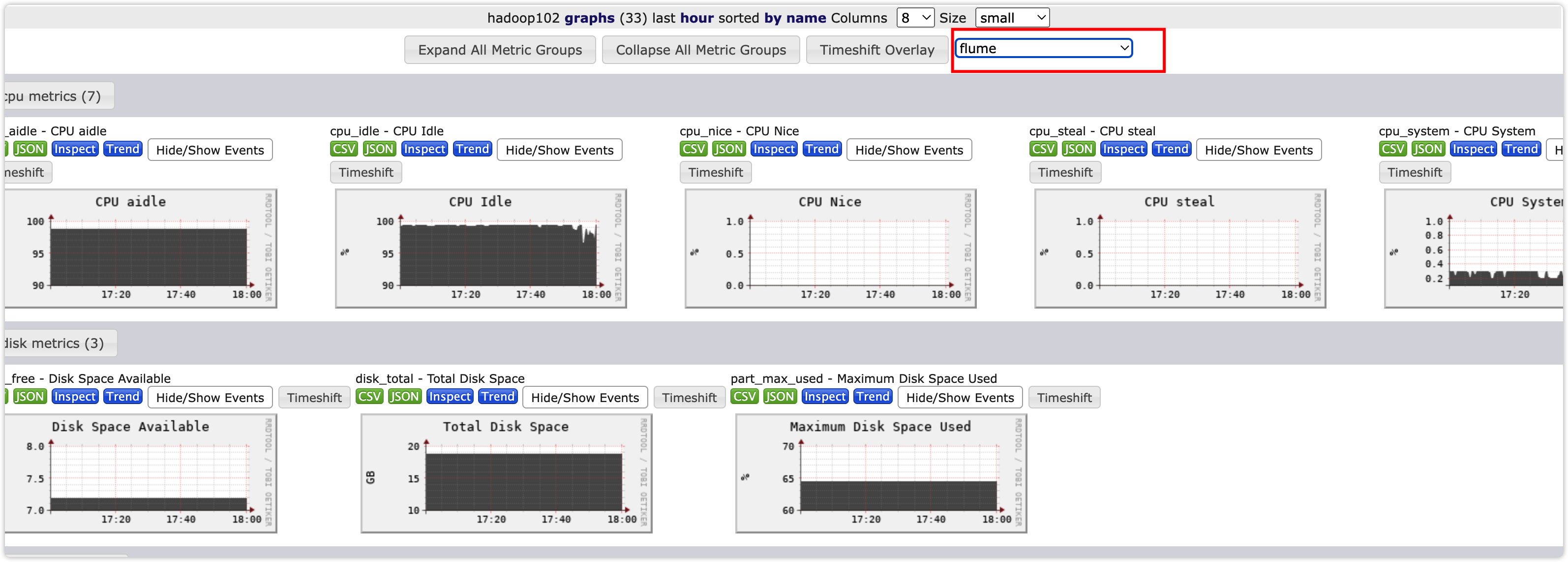
图例说明:
| 字段(图表名称) | 字段含义 |
|---|---|
| EventPutAttemptCount | source尝试写入channel的事件总数量 |
| EventPutSuccessCount | 成功写入channel且提交的事件总数量 |
| EventTakeAttemptCount | sink尝试从channel拉取事件的总数量。 |
| EventTakeSuccessCount | sink成功读取的事件的总数量 |
| StartTime | channel启动的时间(毫秒) |
| StopTime | channel停止的时间(毫秒) |
| ChannelSize | 目前channel中事件的总数量 |
| ChannelFillPercentage | channel占用百分比 |
| ChannelCapacity | channel的容量 |
IT学习网站
Spring Cloud Alibaba学习资源推荐
Spring Cloud Alibaba 微服务架构实战
链接: https://pan.baidu.com/s/1nJpfbjPyf3n339INybjOQQ?pwd=8t11 提取码: 8t11
--来自百度网盘超级会员v4的分享
失效加V:x923713




